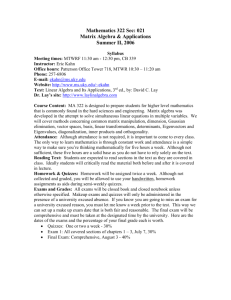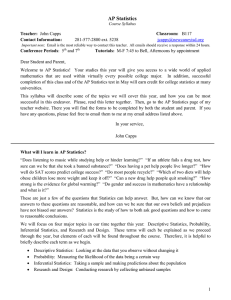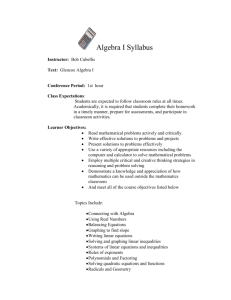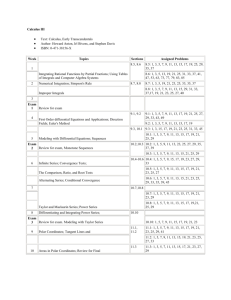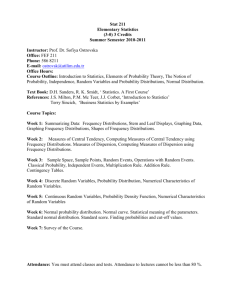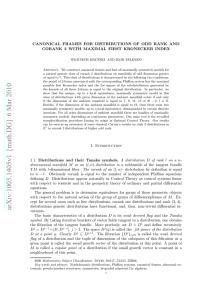MBA 925 Summer 09 Sy..
advertisement
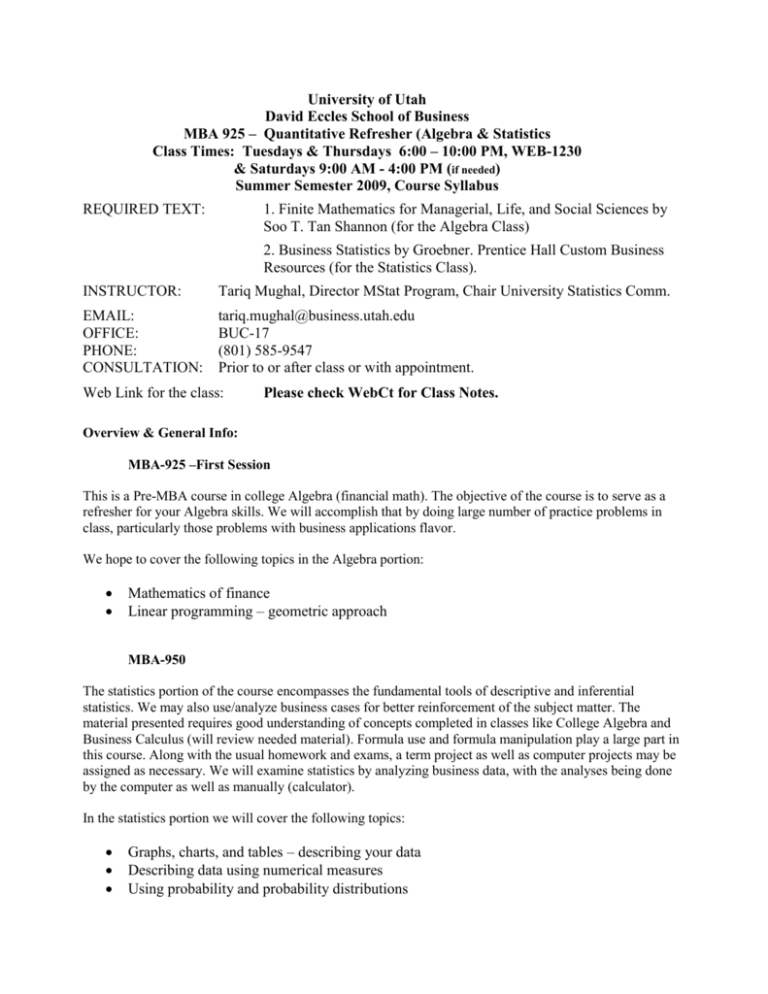
University of Utah David Eccles School of Business MBA 925 – Quantitative Refresher (Algebra & Statistics Class Times: Tuesdays & Thursdays 6:00 – 10:00 PM, WEB-1230 & Saturdays 9:00 AM - 4:00 PM (if needed) Summer Semester 2009, Course Syllabus REQUIRED TEXT: 1. Finite Mathematics for Managerial, Life, and Social Sciences by Soo T. Tan Shannon (for the Algebra Class) 2. Business Statistics by Groebner. Prentice Hall Custom Business Resources (for the Statistics Class). INSTRUCTOR: Tariq Mughal, Director MStat Program, Chair University Statistics Comm. EMAIL: OFFICE: PHONE: CONSULTATION: tariq.mughal@business.utah.edu BUC-17 (801) 585-9547 Prior to or after class or with appointment. Web Link for the class: Please check WebCt for Class Notes. Overview & General Info: MBA-925 –First Session This is a Pre-MBA course in college Algebra (financial math). The objective of the course is to serve as a refresher for your Algebra skills. We will accomplish that by doing large number of practice problems in class, particularly those problems with business applications flavor. We hope to cover the following topics in the Algebra portion: Mathematics of finance Linear programming – geometric approach MBA-950 The statistics portion of the course encompasses the fundamental tools of descriptive and inferential statistics. We may also use/analyze business cases for better reinforcement of the subject matter. The material presented requires good understanding of concepts completed in classes like College Algebra and Business Calculus (will review needed material). Formula use and formula manipulation play a large part in this course. Along with the usual homework and exams, a term project as well as computer projects may be assigned as necessary. We will examine statistics by analyzing business data, with the analyses being done by the computer as well as manually (calculator). In the statistics portion we will cover the following topics: Graphs, charts, and tables – describing your data Describing data using numerical measures Using probability and probability distributions Discrete and continuous probability distributions Sampling distributions Estimating population values Confidence interval estimates Other Policies Attendance: No attendance is taken but you are responsible for everything that is discussed in class. Since this is only a six weeks class your absence will adversely affect your score on active class discussion. You will do some work individually and some in teams. There will be some in-class quizzes and some take home quizzes. Your total grade will be a composite of both. It is important that you do show up to class. If for any reason you have to miss class, please keep in touch with your classmates and make up the missing work. Homework: Homework will be assigned to help prepare for exams. However, they will not be collected and graded. Instead, they will be discussed in class. Make-up exams: No make-ups will be given. If you are going to be absent during an exam for an official school function or medical reasons, please contact me so that arrangements can be made. Academic honor code: We will follow University’s policy and procedures on academic honesty. Americans with Disabilities Act: If you have a disability for which you will need accommodation in this class, please let me know as soon as possible. Tentative Course Schedule Week 1, May 18th Financial Mathematics Week 2 , May 25th Financial Mathematics Week 3, June 1st Systems of Linear Functions and Linear programming In-class & take home exam Week 4, June 8h Graphs, charts, and tables – describing your data, describing data using numerical measures, Using probability and probability distributions Week 5, June 15th Discrete and continuous probability distributions, Sampling distributions Week 6, June 22nd. Estimating population values, Confidence interval estimates In-class & take home exam Grading: Your course grade consists of two parts. First 70% of your grade in each of the classes is based on your performance in the in-class and take home quizzes. The second 30% is based on your class participation. Class participation is defined as asking questions (any questions), actively participating in class discussions, getting to know your classmates and lastly, class attendance. 93 or above 90-92 87-89 83-86 80-82 77-79 = = = = = = A AB+ B BC+ 73-76 70-72 67-69 63-66 60-62 below 60 = = = = = = C CD+ D DF
